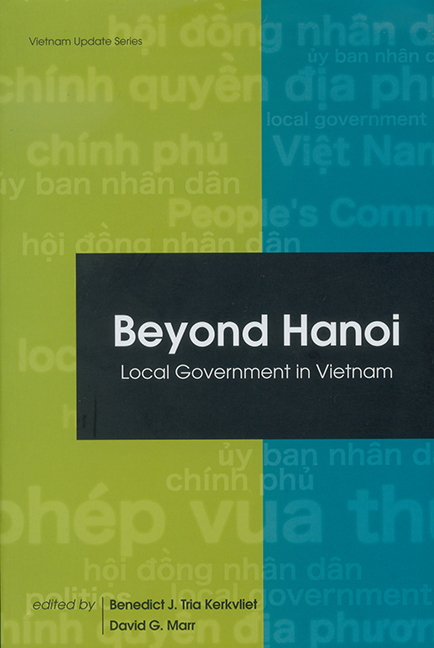Book contents
- Frontmatter
- Contents
- Preface
- Abbreviations
- 1 Surveying Local Government and Authority in Contemporary Vietnam
- 2 A Brief History of Local Government in Vietnam
- 3 Village Government in Pre-colonial and Colonial Vietnam
- 4 Caught in the Middle: Local Cadres in Hai Duong Province
- 5 Winter Crop and Spring Festival: The Contestations of Local Government in a Red River Delta Commune
- 6 Local Politics and Democracy in a Muong Ethnic Community
- 7 Local Government in the Exercise of State Power: the Politics of Land Allocation in Black Thai Villages
- 8 Urban Government: Ward-level Administration in Hanoi
- 9 The Facilitators of Rural Transformation and Development: The Role of Agricultural Extension Officers in Two Districts of Long An Province
- 10 Ho Chi Minh City's Post-1975 Political Elite: Continuity and Change in Background and Belief
- 11 Push, Pull, and Reinforcing: The Channels of FDI Influence on Provincial Governance in Vietnam
- Glossary of Vietnamese Terms
- Index
- About the Contributors
8 - Urban Government: Ward-level Administration in Hanoi
Published online by Cambridge University Press: 21 October 2015
- Frontmatter
- Contents
- Preface
- Abbreviations
- 1 Surveying Local Government and Authority in Contemporary Vietnam
- 2 A Brief History of Local Government in Vietnam
- 3 Village Government in Pre-colonial and Colonial Vietnam
- 4 Caught in the Middle: Local Cadres in Hai Duong Province
- 5 Winter Crop and Spring Festival: The Contestations of Local Government in a Red River Delta Commune
- 6 Local Politics and Democracy in a Muong Ethnic Community
- 7 Local Government in the Exercise of State Power: the Politics of Land Allocation in Black Thai Villages
- 8 Urban Government: Ward-level Administration in Hanoi
- 9 The Facilitators of Rural Transformation and Development: The Role of Agricultural Extension Officers in Two Districts of Long An Province
- 10 Ho Chi Minh City's Post-1975 Political Elite: Continuity and Change in Background and Belief
- 11 Push, Pull, and Reinforcing: The Channels of FDI Influence on Provincial Governance in Vietnam
- Glossary of Vietnamese Terms
- Index
- About the Contributors
Summary
Wards (phuong) are the urban contact points between the state and ordinary people in Vietnam. Ward officials implement state policies and enforce the law. This chapter examines how effective the ward is in achieving state objectives. I argue that the ward, set up to mobilize party and state goals, is also an agent for mediation and negotiation of state policies. Ward organization and operation, this study will show, make mediation possible.
First, I analyse the ward's structure and the informal networks beneath the ward. Analysis of the ward's organization forms the first section of this chapter. The second section examines the ward model of urban neighbourhood administration in Hanoi, in particular highlighting the many approaches and obstacles wards have faced since their establishment.
Much of the research for this chapter was done in Hanoi, in 1997–98. Then, as now, the top level of local administration was the Hanoi People's Council and People's Committee. At the next level downwards are the districts: quan in urban areas; and huyen in rural areas. In 2002, Hanoi had six urban districts. Each urban district was divided into smaller units, called wards, the third and lowest level of urban government. Hanoi had 85 wards in 1997 and the number of wards has increased since then. Putting this number in context, in October 1997, Vietnam had 8,823 communes (xa), 520 small towns (thi tran), and 949 wards. The country's wards administered around fifteen per cent of the population, even though they covered only about one to two per cent of national territory.
Each ward in Vietnam has three administrative and governing components: People's Council (hoi dong nhan dan), People's Committee (uy ban nhan dan), and ward branch (dong uy phuong) of the Communist Party. The People's Council (a resident-elected assembly representing the people and the state) and the People's Committee (executive agent of the state and of the People's Council) are part of the state apparatus outlined in the nation's Constitution.
- Type
- Chapter
- Information
- Beyond HanoiLocal Government in Vietnam, pp. 197 - 228Publisher: ISEAS–Yusof Ishak InstitutePrint publication year: 2004

